In a beneficiation plant,thickeners are essentially clarifiers producing a clearer over flow. The design considerations are based on the settling rates of the slowest settling particles and conditions for minimum disturbance of the medium (water) through which the solid particles are allowed to settle.
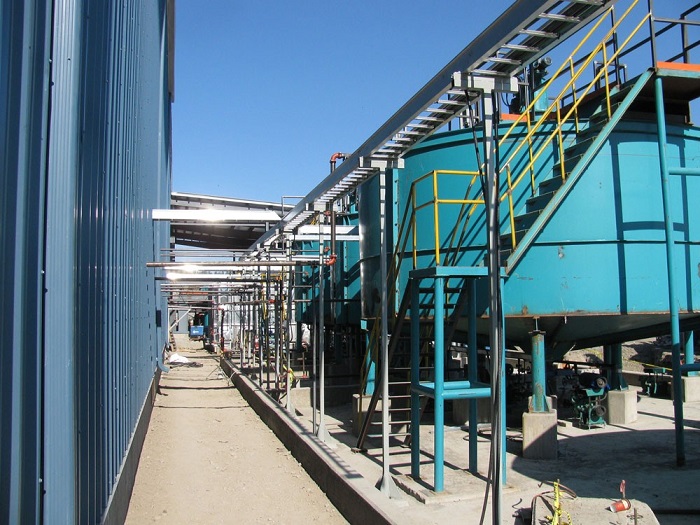
To achieve these objectives cylindrical tanks with conical or flat bottoms are used and the velocity of the feed slurry entering the settling tank is minimised to reduce turbulence in the settling tank. A schematic diagram of a typical thickener is shown in Fig.1. The feed in the form of slurry is generally guided by a launder, which is laid at a slope just sufficient for the slurry to flow without depositing any solids. The feed launder terminates in a feed well located at the centre of the tank. The feed well is designed to break the fall of the slurry and dissipate the energy.
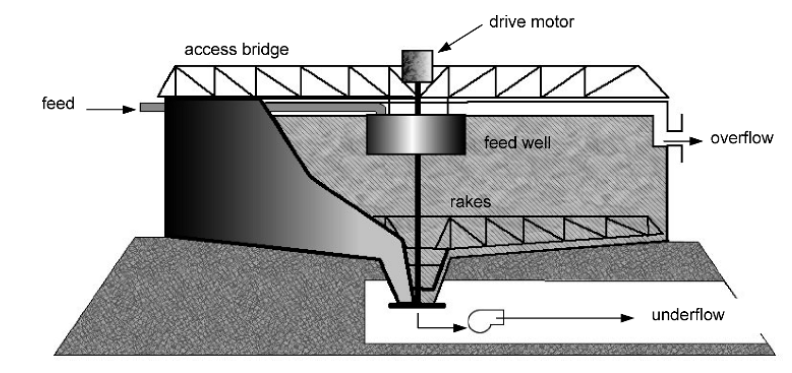
Fig1. Sketch of bridge type thickener
The feed well is concentric with the rake driving shaft. The rakes are bolted or welded on to this drive shaft and for long and large rakes they have additional support from cables. Usually four rakes are employed of which two may be short and two long. Attached to the rakes and below them are spikes, particularly in situations where the sludge is thick. The spikes help to break up the sludge and render it more suitable for pumping. The rakes are driven by a motor which is mounted on a plate above the well. An alternative is to mount the drive motor on a track running along the rim of the tank. A bridge usually runs from the periphery to the centre of the tank. It is supported by the wall of the feed well and the rim of the tank. The bridge serves as a walkway and also carries an open launder (or pipe), which carries the slurry to the feed well. In some designs the bridge spans the entire length of the tank. As in clarifiers, the bottom of most tanks slope towards the centre where the thickened underflow sludge accumulates. When a flat bottomed tank is designed, the settled sludge builds up to form its own slope depending on the angle of repose of the material thus forming an artificial sloping tank bottom. The sludge collected at the bottom is discharged through an outlet shaped like a cone with steep cone angle. Alternately, the thickened slurry is swept towards a trench at the bottom of the tank. Usually a scraper is installed for smooth delivery of sludge from the discharging cone or trough. A slush or centrifugal pump subsequently removes the sludge. The thickener tanks are usually fabricated using steel sheets. But tanks with concrete sides are quite common. Some small tanks (usually < 30 m in diameter) are made of plastics.
The whole assembly is installed either above ground sitting on pillars or at ground level with the discharge well below the ground level. In the latter case, an access tunnel is provided where the discharging pump is located. In some installations the discharge pump is located above the tank; in such cases, a suction pipe runs down the centre column to the bottom well. Alternatively, a submerged motor pumps the under flow slurry to the top of the tank discharging its contents to a holding tank. Several variations are known to exist. For instance the rakes are either supported by cross beams or truss above the tank or supported by the central column and cables. The cables are also connected to torque meters. Fig.1 is a sketch of a bridge thickener where the bridge runs across the thickener tank. The bridge support the rakes and the motor rotating the rakes sit on a platform in the centre of the tank. The rakes are bolted to the central column which is rotated by the motor. The Bridge thickeners have a maximum diameter of about 30 meters.
When the rakes are supported entirely by the central pillar, the access bridge usually runs half way on the tank surface terminating on the central pier. The centre pier thickeners are considerably larger than the Bridge type. The diameter of the tank ranges from about 35-180 meters.
A variation is the tray thickener where trays or compartments are placed one on top of the other. Each tray acts as a thickener and the assembly operates in parallel with a common pier or shaft where the rakes are fixed. Clarification takes place in series operation, that is, the thickener underflow from the top compartment serves as feed to the lower compartment. Ultimately the underflow from say, a six tray thickener, form the final thickened underflow. Similarly all the overflow from each tray combine forming the final overflow slurry. Fig.2 is a schematic diagram of a 3-compartment clarifier. Up to seven compartments are available.
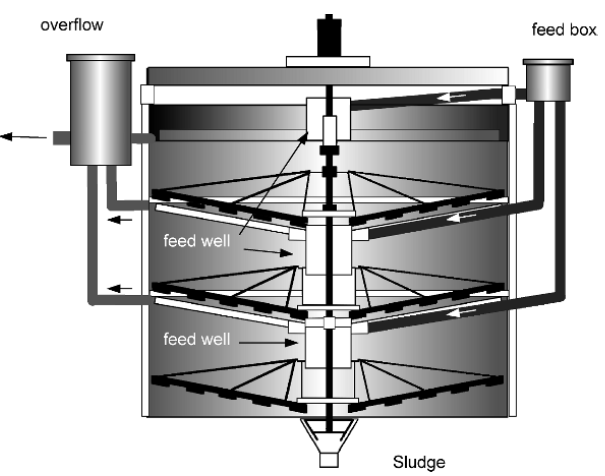
Fig2. Schematic diagram of a tray type clarifier
The thickening process is accelerated by the addition of flocculants Hi-Capacity thickeners allow a mixing arrangement in the feed box where the flocculant is intimately mixed. The other design features of the Hi-Capacity thickeners are similar to the Bridge thickeners. While installing the feed pipe or launder to thickeners, the slope is held at 1 to 1.5. this slope provides minimum turbulence of the settling slurry in the tank.The feed is actually made to enter about a meter below the surface of the tank level thus helping to minimise turbulence. The feed well diameters are between 1 and 1.2 m with lengths of 1.2 to 5 m. Tank sizes vary according to feed characteristics and the sedimentation time. Sinonine suggested that the water depth should be between 3.0 and 3.6 m and the feed well size about 25% of the basin area.
A recent innovation is the E-Cat thickeners which has dispensed with the rakes and introduced clarifying cylinders through which the suspension passes to produce the clear over flow (Fig.3). These thickeners are designed for rapid sedimentation by the use of flocculants. The clarified slurry then passes through filters producing a clear overflow.
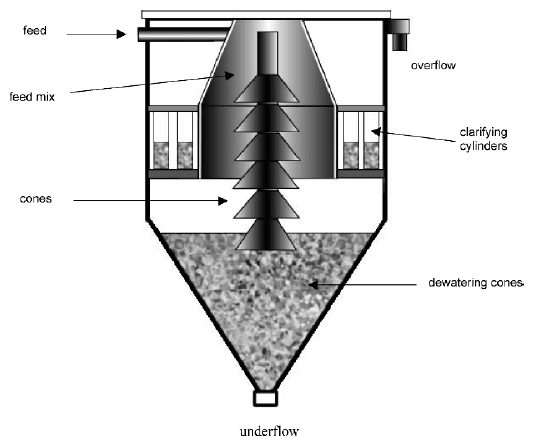
Fig3.E-cat thickener
Thickener Design-Batch Process
Thickeners have been designed using the basic laws of sedimentation. Empirical methods devised by manufacturers are also used for rapid work. For designing , the chief criterion is to determine the relation between the settling velocity and the dimensions of the vessel to be used for each particular slurry. The settling velocity for a particular slurry can be easily determined in the laboratory by using small-scale tests. The tests consist of determining the downward movement of the boundary of the clear liquid and the suspension. It has been found that this rate is initially constant but the rate decreased as the particles slowly settled to the bottom and the interface met the sludge zone. This can easily be visualised from Fig. 4 where the progressively increasing concentration with depth is shown. It is obvious that the deeper the vessel and longer the time given for settling, the clearer will be the supernatant liquid and the thicker will be the sludge.
The decrease in the settling rate is due to hindrance by increased crowding of the particles as they settle and collect at the bottom of the vessel. At the sludge-forming layer, the particles pack down by displacing the liquid in between. In so doing, the clear liquid level rises. These considerations apply both to batch and continuous processes, with the difference that in the continuous process a balance between the flow rate of the overflow stream and the removal rate of the sludge has to be maintained.

Fig. 4 Sedimentation in a thickener
Operation of thickeners
The operation of thickeners involves a delicate balance of the feed rate, the overflow rate and the underflow withdrawal rate and is dependant on the concentration of the feed, overflow and underflow streams The feed stream generally enters the feed well at a speed of about 15 m/min but this would depend on its characteristics, such as concentration (liquid/solid ratio), particle size, particle shape and viscosity. The characteristics of the overflow and underflow streams depend on the sedimentation time and particle properties like, specific gravity, shape , size and wettability. If the particles are very small, the associated surface charge or zeta-potential is of importance.
Flocculants play an important role in affecting the surface charge on particles and help to accelerate or reduce the rate of sedimentation by dispersion or agglomeration.
Rakes help to increase the sedimentation rate and also break up large agglomerates. The rakes are operated between 8-18 m/min. To prevent damage to the rakes and torque meters the recommended operation is to discharge the sludge at regular intervals at predetermined set conditions. It is necessary for the operator to detect the build up on the rakes and operate to avoid the jamming and seizure of the rakes. Usually the built-up mud tends to form islands which grows and develops a moment that could easily damage the rake mechanism. During normal operation the rise rate varies from about 0.01—0.03 m /min/m of cross-sectional area and the detention time is between 2-5 hours.
Thickeners in Circuits
In minerl processing plant ,Thickeners used to produce low solid overflows (eg. about 1% solids), may be referred to as clarifiers. Both thickeners and clarifiers are extensively used in metallurgical operations for dewatering purposes. In processing gold, nickel, iron, copper ores etc. thickeners are used to produce overflows suitable for use as process water in circuits such as flotation machines. The clear overflow water is used for re-pulping the flue dusts or fine dust from precipitators. Therefore the feed to thickeners vary considerably. A common arrangement is illustrated in Fig.5
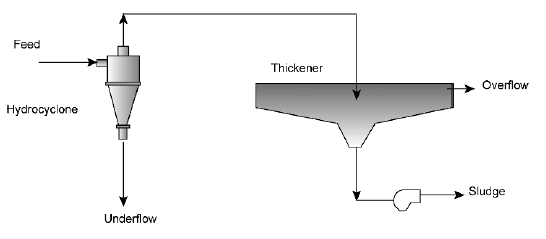
Fig5. Thickener arrangement
Thickeners serve as classifiers when a near clear overflow is required. For example clarifiers used in iron blast furnace dust cleaning plant or electrostatic precipitator circuits are required to produce clean overflows as the water is for reuse and the sludge is for secondary use. In such cases the sludge is washed continuously by counter current decantation, where the underflow from a thickener/clarifier is pumped to the next thickener/clarifier (connected in series) forming the feed to the second tank. A typical set up is illustrated in Fig. 6 consisting of three units of thickeners/clarifiers.
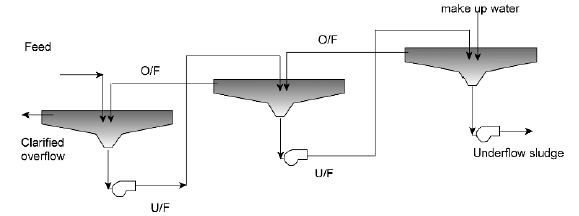
Fig6. Thickeners in a counter-current decantation arrangement
Such setups are structured so that the overflow from one clarifier/ thickener flows by gravity to the adjacent clarifier. The sludge is usually pumped to the next clarifier. Make up water is added at the third thickener.